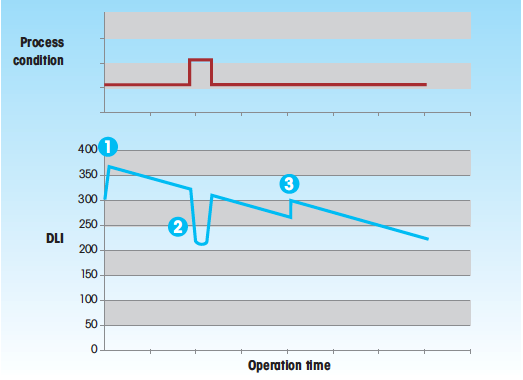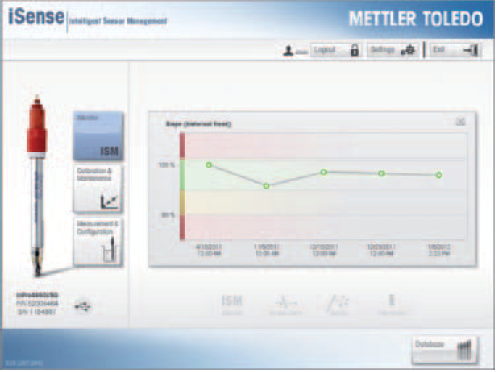Plant safety and process reliability often rely on analytical instruments operating correctly, which means sensors must be kept in good condition. This requires regular maintenance and servicing. But knowing exactly when to maintain, service or replace a probe has been very imprecise. Cutting-edge measurement systems that utilize intelligent sensors that learn from your processes, take all guesswork out of maintenance decisions. This technology also reduces the possibilities of human-error and lowers instrument lifecycle as well as production costs.
Introduction Failure of analytical sensors in a process can lead to poor product quality, over- or underuse of reagents, or production downtime. And if a sensor is required for safety purposes, its failure can have devastating consequences. Therefore, instrumentation engineers spend a great deal of time ensuring measurement points are operating reliably. However, it has been estimated that as much as 60% of sensor maintenance is conducted needlessly.1
And despite all this maintenance, half of industrial accidents are maintenance related.2 Further, 20% are due to human error.3 Hence, an increasing percentage of chemical plant expenditure is devoted to safety aspects.
Until recently, deciding if and when to perform sensor maintenance or replacement has been based on a combination of past experience and guesswork. Now, a new technology removes all measurement system uncertainty and allows sensor maintenance to be conducted in a safe environment. This technology not only increases process reliability and plant safety, it also significantly reduces the costs of operating a measurement system over its lifetime.
On-board intelligence
Intelligent Sensor Management (ISM®) is an innovative digital technology for analytical process parameters that combines many features into a unique solution.
The foundation of the technology is built from a microprocessor embedded in all ISM sensors. This allows a wealth of valuable features that analog sensors cannot compete with, including: a robust digital signal; fast, error-free measurement point start up; and advanced diagnostics that clearly inform operators when calibration, maintenance or replacement will be required.
Predictive diagnostics for efficient maintenance
In chemical plants, maintenance is often conducted on a scheduled basis, and an analytical sensor might be calibrated even though it may not actually be needed. In other situations, plant engineers may wait until they think there is an issue with a measurement point. By which time, the concerned process or plant equipment may be detrimentally affected. ISM’s diagnostics tools have solved these issues.
When an ISM pH sensor is installed in a process, it does not just measure pH with great accuracy. It very quickly learns how conditions in the process will affect its ability to measure reliably over time, and therefore, when it will need to be calibrated, serviced and replaced. This data, displayed as easy-to-read tools, means that maintenance can be scheduled based on actual requirements. ISM diagnostics allow a measurement point to be optimized on an ongoing basis and for all critical situations to be predicted, so that maintenance staff can respond before production is affected. And because measurement point maintenance only happens when it is required, operators can be certain that resources are not being wasted. With ISM, measurement point maintenance is converted from being a passive, costly, and unpredictable workflow, to a fully safe and controlled procedure.
The key diagnostics tool in ISM is the Dynamic Lifetime Indicator (DLI).
Sensors That Learn The DLI provides technicians with a clear indication of how much the exposure to a process has altered a sensor’s condition. In the case of pH sensors, by continuously analyzing the process conditions and other factors, the DLI constantly calculates the remaining reliable lifetime of the sensor. If process conditions become more or less harsh, the DLI rapidly responds appropriately. In addition, the DLI actually adapts to process conditions to ensure diagnostics data is always reliable. (fig. 1)
Through observing the DLI (or via transmitter alarms), pH sensors with a short remaining lifetime can be replaced pre-emptively before they fail during operation, resulting in improved safety, higher process integrity and fewer product quality fluctuations.
The DLI, and all other ISM diagnostic tools, are viewable on ISM transmitters and iSense software (see below). They can also be integrated into asset management systems for remote monitoring.
Fig. 1: 1. The DLI rapidly adapts to process conditions. 2. An increase in process stress corresponds to a drop in the DLI. 3. During calibration on iSense software (see below), additional sensor data finetunes the DLI.
iSense – a digital sensor expert
iSense is Windows-based software for ISM sensors that runs on PCs, laptops and mobile devices. It is the hub for all ISM sensor activities, including calibration and maintenance, and provides a fully controllable method of managing sensors and maximizing their use.
All calibration and maintenance routines on iSense are accompanied by easy-to-follow animations. These reduce the requirement for training and ensure that every procedure is performed without mistakes or missed steps.
A few of iSense’s main features are outlined below
At-a-glance view of sensor condition Understanding ISM’s diagnostics tools does not require the interpretation of complex data. The iMonitor diagnostics display on the M800 transmitter and iSense (fig. 2) uses traffic light color coding to give an at-a-glance overview of sensor “health” in the field or in the maintenance shop.
Performance charts (fig. 3) for sensor data such as pH sensor slope, allow users to visualize unexpected changes in a probe’s status caused by adverse process conditions.
Greater diagnostics accuracy
When a sensor’s connected to iSense, detailed information (e.g. slope and zero point of pH probes) is used to fine-tune the DLI. This provides greater diagnostics accuracy when the sensor’s reinstalled in a process.
Further, the DLI and other vital sensor data are also viewable and recordable on iSense. This gives users a single point which archives the condition of the installed sensor base.
Transfer knowledge between sensors
In some applications process conditions mean that it can take a few days for sensor diagnostics to stabilize.
An ISM sensor can learn from another sensor that has already been used in an application. For example, when a pH probe is removed from a process and is connected to iSense, information on the conditions of that particular process can be stored as an application profile. This profile can then be transferred into a different pH sensor.
When this second sensor is installed in the same process, because of the transferred knowledge, it does not need time to acclimatize and already knows when it will need to be serviced or replaced. If conditions in the process alter, the sensor diagnostics adjust themselves appropriately.
Convenient calibration, easy traceability
Due to the location of measurement points, sensor calibration is often inconvenient and it can even compromise staff safety through possible exposure to hazardous environments. iSense offers accurate sensor verification and calibration in any convenient location such as a maintenance shop. And because ISM sensors retain their own calibration data, sensors can be easily and quickly exchanged in the field (see Plug and Measure below).
iSense’s electronic user management logbook allows control and tracking of all sensor activities, ensuring complete documentation of ISM sensors over their lifetime, to meet internal or external requirements.
Plug and Measure – fast and simple start up
Once an ISM sensor has been calibrated, it can be stored until required. Further, when connected to an ISM transmitter, the precalibrated sensor is instantly recognized and the transmitter configures itself appropriately without any operator intervention. Now when an exchange of sensor is needed, this Plug and Measure functionality means a pre-calibrated sensor can be installed and be ready to measure in under a minute. This substantially reduces the time maintenance staff need to spend at measurement points.
Fig. 2: The iMonitor display on iSense provides an easy to interpret overview of a sensor’s condition.
Significant cost savings can be achieved
Calibration away from the process and Plug and Measure result in much lower sensor maintenance expenditure. Time spent on maintenance can be reduced by as much as 80% by adopting ISM systems.
However, reduced maintenance is not the only avenue to cost savings. A standard pH sensor that requires calibration combined with an interference-prone analog signal can mean that a transmitted pH measurement may be off by 1 pH unit or more. If a process involves the feeding of reagents to raise pH, a reading that is 1 pH unit lower than the true value means ten times more reagent is being used than is required.
ISM’s digital signal and diagnostics data allows operators to prevent such overuse from occurring.
ISM solutions across your processes
ISM is not only for pH measurement. Solutions for dissolved and gas oxygen as well as conductivity are also available. For safety critical processes, a range of in situ tunable diode laser gas analyzers combine exceptional ease of installation and use, with high accuracy and reliability.
Fig. 3: The display of a pH sensor’s slope or offset over time allows users to identify how process conditions have affected a sensor
Seamless integration of diagnostics data
The invaluable sensor diagnostics data that ISM provides does not stop at the transmitter. Integration through HART®, PROFIBUS® or FOUNDATION fieldbus™ into control systems and asset management software allows real-time monitoring of sensor performance from the convenience of a maintenance room. This means that if production staff are away from the process and a measurement point needs attention, it will be noticed instantly.
A range of advanced multi-parameter, dual/multi-channel, and mixed-mode (accepts ISM and conventional analog sensors) transmitters further ensure the adaptability of ISM solutions to your needs.
Conclusion Chemical plants have two main areas of concern: production efficiency and quality; and plant, staff and environmental safety. In-line process analytics often has a significant role to play in both respects.
Achieving the best performance from in-line sensors demands that they be kept in good operating condition. However, sensor maintenance is often conducted to a fixed schedule, meaning that a probe might be cleaned, calibrated or even replaced when it is not necessary. This costly use of resources is due to lack of information as to what tasks actually need to be performed and when.
With its highly informative diagnostics that adapt rapidly to process conditions and its robust digital signal, combined with the transfer of application knowledge between sensors, ISM offers efficiencies in maintenance planning, plant safety and productivity while also reducing production costs.
To find out more about Westech Industrial’s Mettler Toledo product line please visit our website at https://westech-ind.com/ or call and speak to one of our technical representatives at 1-800-912-9262.
Share This:





 CDN NEWS |
CDN NEWS |  US NEWS
US NEWS 



































